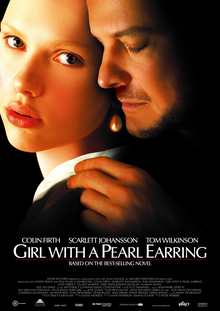I love Renaissance art. I took a class on art history in college and I definitely fell in love with both the architecture and the art of the Renaissance period. One of my favorite pieces is "Girl with a Pearl Earring" by Johannas Vermeer. I loved this painting because it is so striking -- the girl staring out from the frame, not beatifically like the Mona Lisa, but with almost a question in her face. as if she's almost surprised to be caught off-guard, and found someone painting her.
Girl with a Pearl Earring, by Tracy Chevalier, is my favorite kind of historical fiction. Chevalier takes a painting with an unknown history -- we know nothing about who the subject is, or what inspired Vermeer to paint her, or why she is wearing that particular headgear -- and creates a story around it, to explain the whos, whys, and hows of the painting's existance.
Griet is sixteen years old when her father is blinded in an accident and she is forced to take up work as a maid in order to assist her family financially. She is employed in the home of the painter Johannes Vermeer, where she quickly discovers that the only bright part of her life is tidying the studio where he works. Griet is enamored, first of the colors and the paintings, and then slowly, over the years, of Vermeer himself. Yet, when Vermeer's hands are tied by a wealthy patron into painting a portrait of Griet herself, she realizes she is caught between two worlds -- the one to which she has always felt she belongs, and the world of Vermeer's paintings, which only he can see.
Griet is a unique character. She is stern, upright, honest, and proud, although she states numerous times that her family's tragedy and her lowly employment give her no reason to be. She is not a sympathetic character because she does not allow anyone to pity her. She is a lady unsure of what she wants. Although she has more gravity and self-reflection than her betters, when it comes to seeing the world around her, Griet is very uncertain, not as to where she should go or what she should be, but of how much she wants it. She baffles everyone around her, for many reasons -- Vermeer's wife because she is suspicious of her motives; his mother-in-law, who grudgingly accepts her though she feels Griet does not know her place; the butcher's son, her beau, who does not understand why she does not leap at the chance to marry him and free herself from a maid's life. The only person who asks nothing of her, who says nothing about her future, is Vermeer himself. And while this enamors Griet, she begins to wonder if he truly cares for her, or if she's just a pretty face in his painting.
As part of the Nest Spring Book Challenge, I watched the 2003 film adaptation of the book. The film stars Scarlett Johannson as Griet and Colin Firth as Johannes Vermeer. It is a good film, when taken by itself, free of the novel. Scarlett was made to play the part of Griet, and she is perfectly matched to the book's description both physically and vocally. I love Colin Firth as an actor, and I think he looks great for the role, but the part of Vermeer is over-stressed in this film. The relationship between Griet and the painter is so delicate, so barely stressed in the book, that you wonder whether or not it's even there. Does Vermeer have feelings for Griet, or is it all in her own mind? Or is it based on the painting? There is no question as to this in the film. Even the movie poster (left) is indicative of this. Griet's face is not the gentle look of surprise that the original painting boasts. Instead, she looks shocked, almost trapped. Firth is touching her as he would a lover -- this does not happen in the book. There is only one instance where Griet and Vermeer touch, and it is nothing as erotic as the poster would lead the viewer to believe. The ending of the film also goes unexplained, and seems hurried, almost rushed. There is zero character development for Griet in the film. Where in the end of the movie, every decision made is her own, she is an adult who is finally ready to seize her destiny, in the film, it is thrust upon her, and she has no choice in the matter. I think the film would be a lot more enjoyable if taken on its own, rather than in comparison to the book.
Rating: **** and 1/2 (book), ** (film)
Rating: **** and 1/2 (book), ** (film)


I actually watched the film first and I liked it, so I decided to give the book a chance and loved it! This is Holland in the 17th century where a young girl named Griet is forced to work at the house of Vermeer. She tells the story in first person. I felt her pain having to leave home at such a young age. Women did not have many options during that era, either give in to men or be cast out, which Griet battled with. So many times I thought her and Vermeer would make a love connection, and Chevalier definitely added that romantic stress to the plot. As for the painting, the pearl earring was Vermeer's wife's possession and she was quite the vindictive lady, which unfortunately, Griet had to deal with the wrath of her jealousy.
ReplyDelete